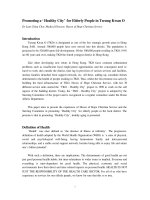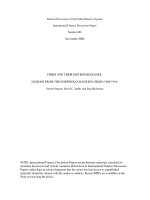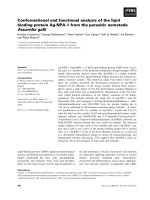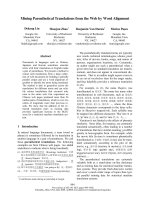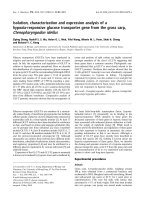ICT for elderly people: Final report from the consensus conference of The Norwegian Boar of Technology pot
Bạn đang xem bản rút gọn của tài liệu. Xem và tải ngay bản đầy đủ của tài liệu tại đây (95.04 KB, 18 trang )
ICT for elderly people
Final report from the consensus conference of The Norwegian Board
of Technolo
gy
ICT for elderly people Page 2
Preface
The Norwegian Board of Technology organized a consensus conference on elderly people
and information and communication technology. The report contains a statement of the
lay-people panel from the conference 16. - 19. 6. The statement was handed over to the
chairman of The Standing Committee on Health and Social Affairs, John I. Alvheim.
The point of departure of the commitment to this topic area on the part of The Norwegian
Board of Technology is an increasing portion of elderly people in the population,
development of new communication, security and information technology, comprehensive
municipal construction of health care housing and shortage of health care personnel. The
consensus conference dealt with both elderly people’s use of ICT as a means of
communication and the use of ICT in housing for the elderly (smart-home technology). The
main topic, which the lay-people worked on, is whether information and communication
technology (ICT) may cause elderly people to become independent and support society in
taking care of old people and people with dementia in a worthy and humane manner.
The Norwegian Board of Technology 2000
ICT for elderly people Page 3
Table of Contents
Table of contents page
Preface 2
Chapter 1 Introduction 4
Chapter 2 Main perspective 5
2.1 Nursing and caring 5
2.2 ICT training for elderly people 6
Chapter 3 Body of laws 8
3.1 Bodies of laws that regulate the use of ICT in nursing and welfare services 8
3.2 Body of laws regulating ICT training 8
Chapter 4 Ethics 10
Chapter 5 Political and economic perspective 13
Chapter 6 The composition of the lay-people panel 15
Chapter 7 The organisation and procedure of the consensus conference 16
7.1 Choice of conference form and topic 16
7.2 Selection of lay-people 16
7.3 The lay-people's preparation 17
7.4 Selection of experts 17
7.5 The conference day by day 17
ICT for elderly people Page 4
Chapter 1 Introduction
Information and communication technology (ICT) characterises today’s society. Side by side
with technological development we will within the next few years be faced with a greatly
increasing number of elderly people.
What are the concrete challenges connected with elderly people and information and
communication technology? How can positive possibilities be exploited and negative effects
avoided?
The lay-people panel has on the instructions of The Norwegian Board of Technology carried
out corresponding discussions on two major topics. These are as follows:
Elderly people’s use of ICT in their daily lives
Use of ICT in health care and welfare services for old people and people with
dementia
We have mainly regarded elderly people’s use of information technology in their daily lives
as ICT training of elderly people. We have also discussed the possibilities and limitations
that technology raises for information, activity and for better contact with others.
The use of ICT in nursing and care of elderly people mainly implies in this connection the use
of smart-home technology in houses for old people and people with dementia. This
technology involves the use of integrated ICT components. Examples of such smart-home
technology/caring technology are among other things photoelectric cells (sensors) that can
automatically detect dangerous situations such as old people falling, over-heating of
cookers or outer door sensors that give warning of entrance or undesirable “movements”.
Legal and ethical questions of control, supervision and consent in connection with such
smart-home technology have in this connection played an important role for us.
According to "Eldres IT-forum" (an IT-forum for the elderly) “elderly people” are those above
55 years, and they represent one fourth of the Norwegian population. The elderly are a
heterogeneous group with very different needs and qualifications. Their economic
capability, degree of education, their health and degree of functional ability greatly vary. In
any case this concerns a large and important part of the population.
ICT for elderly people Page 5
Chapter 2 Main perspective
ICT is important for everybody in today’s society. What exists of means and measures in
order to secure that all groups get similar information and similar possibilities with regard
to ICT. As mentined above the lay-people panel has two main perspectives with regard to
elderly people and ICT; (1) elderly people’s use of ICT (2) to regard ICT in connection with
health care and welfare services for old people and people with dementia.
2.1 Nursing and caring
Elderly people are a heterogeneous group with different needs and capabilities. They have
different need for help, different capabilities and learning ability. Smart-home technology
may be used in different ways in many of these cases, and it presents different challenges
such as:
Use of smart-home technology should give real and realised improvements in the
welfare and security of the user.
The user’s need should always come first.
The number of nurses must be maintained.
Good training of personnel who are to put technology into practice is necessary.
At the introduction of technological solutions to an occupier, information is
important. The occupiers should be informed about what is the purpose of the
technological solution, how it functions, and what use they may get from it.
Many of today’s electronic solutions are special security measures. The security
should be directed primarily towards the users, but may also lead to a feeling of
security for the nursing personnel and relatives on behalf of the users (and
themselves).
It is important to consider individual differences, so that the technology at any case
is adjusted to the situation and need of each individual.
When using smart-home technology, the least radical technological solution must
be adopted.
In order to maintain legal protection at the introduction of smart-home technology
in houses for elderly people, it is important that the demand for informed consent
be observed. In cases of dementia informed consent is problematic, something
which a new and better body of laws should consider.
Mastering of daily life
A great number of elderly people are anxious about not being able to master their every day
lives. For elderly people the use of smart-home technology may give them a feeling of
security in that they are warned in case of for instance, a cooker overheating, or flooding in
the bathroom etc. ICT may function as a memory aid for elderly people who in that way may
experience increased mastering of their own housing situation. Old people with dementia
function better if they may stay on in familiar surroundings. Alteration of their housing
situation may reduce their general condition. Smart-home technology may in this way
ICT for elderly people Page 6
contribute to making it possible for elderly people and people with dementia to remain
living at home for a longer period.
Social contact may be increased by user-friendly telephones, more human care from nurses,
relatives and others.
Security for the personnel
Smart-home technology may give the nursing personnel security in that they will be warned
when dangers occur in other parts of the house. The result is that the nursing personnel can
concentrate entirely on one person at a time. More time may in this way be spent on human
care, instead of control routines. Altered routines lead to less stress and less exhaustion for
nurses. This will in the long run have a positive effect on the occupiers.
Elderly people often have objections to ICT. Ignorance is often a decisive reason. Information
and knowledge about ICT will be important in this connection. It should also be emphasised
that original nursing functions shall be maintained, and that guidelines for this are being
drawn up. ICT should be a supplement to nursing and care.
2.2 ICT training for elderly people
The objective of ICT training of elderly people should be that those who wish to get ICT
training may have it.
How should the training take place?
Training of elderly people today is mainly carried out by ideal organisations on a voluntary
basis. It may seem as if public authorities are not very interested in initiating concrete
measures and economic support. Among the existing activities offered to elderly people
today, we may mention:
schools, cp. the arrangement of optional subjects
libraries
councils for the elderly
clubs for the retired
old people’s clubs
special committees
Folkeuniversitet (Institute of Adult Education)
correspondence schools
county councils etc.
On the first day of the consensus conference Kjell Gunnar Sørensen from Norwegian School
of Pensioners informed about the school’s educational activities. What is special for the
Norwegian School of Pensioners is that they direct all their training towards pensioners.
Their main target group consists of persons above 55 years of age and persons approaching
ICT for elderly people Page 7
the age of 55 (preparation courses for retirement). The school arranges courses on among
other things the basic use of PC/word processing/internet etc. and courses that prepare for
retiring age. These courses are relatively limited with regard to capacity.
Sidsel Bjørneby from Human Factor Solution said in her lecture at the consensus conference
that many libraries all over the country (in addition to their traditional tasks) also give
courses to elderly people on the use of PC and internet. In addition to this, things function in
such a way that elderly people at the library offer user support to other elderly people.
There are also a number of other educational institutions running ICT education, but few of
them run courses geared directly towards elderly people. Besides, much of the training is
relatively expensive, something which may involve differences between elderly people with
regard to acquiring new knowledge in relation to ICT.
The Kongsberg Model
At the consensus conference Torleif Løvgren from Kongsberg presented his experiences
from IT training for senior citizens at Kongsberg - in this report referred to as the Kongsberg
model. The model is to a large extent based on voluntary work, idealism and extensive
cooperation between different voluntary organisations and municipal bodies. According to
this model training of elderly IT users is financed partly by the compulsory state school
system where this activity is offered as an optional subject, the Red Cross offers rooms and
computer equipment in a training centre such as “Open workshop”, the council for the
elderly gives pedagogical guidance to pupils/students and Folkeuniversitetet (Institute of
Adult Education) establishes courses. There are also several similar models for such training,
among others from the Grefsen-Kjelsås part of town in Oslo, where the pupils at the
secondary schools have carried out training of elderly people. These courses have been
positive professionally and socially for both parties. The lay-people wish to encourage the
following bodies and institutions to contribute to give elderly people good ICT training by
gaining experience from among others the training at Kongsberg:
The lay-people panel is of the opinion that the Kongsberg model may easily be transferred
to other municipalities. Further more, the panel recommends that more schools for the
retired be established. The Act on Adult Education gives guidelines for education of adult
students. This might be used by pensioners. Libraries offering PC courses for elderly people
in addition to their traditional tasks should be encouraged to increase the number of such
courses.
ICT for elderly people Page 8
Chapter 3 Body of laws
3.1 Bodies of laws that regulate the use of ICT in nursing and welfare services
We all move through different stages of life. As we grow older we may experience a need for
a number of services from the authorities in order to be able to get through our daily life -
gradually or acutely we may all become more or less in need of help. Old people with
problems of dementia need more help both physically and psychologically. In this
connection different technological installations may be supplementary measures the use of
which may prove to be both correct and necessary. At the present we lack sufficient bodies
of laws for regulating the use of technology within welfare services for old people and
people with dementia. Regulations regarding elderly people, protection of privacy or
technology are scattered in different laws/regulations/guidelines. This makes the bodies of
laws difficult to follow and difficult to relate to for welfare service personnel, among others.
Stortinget (The Norwegian Parliament) has recently passed a new law on personal
information (The Personal Data Act) that is to replace the present Data Protection Act, and
which is expected to come into force 1st January 2001 at the earliest. The new law regulates
only to a certain extent the use of technology in nursing and welfare services.
The lay-people panel is therefore of the opinion that a separate law should be passed that
regulates the use of smart-home technology in housing for old people and people with
dementia.
The contents of a law regulating the technology of welfare services
The lay-people panel is of the opinion that a new law on technology of welfare services
ought to deal with the following:
Anyone being in need of nursing and welfare services, independent of forms of
housing, it being his/her own housing, sheltered-housing or nursing home, shall get
a good offer
The law should be framed in such a way that personal information produced by
technology does not create problems for the protection of privacy. The Legal
protection of each individual must be taken care of.
A good system of internal control of the use of "technology of welfare services"
should be emphasised in the law, so that the use is reliable and in accordance with
the interests of elderly people. This should apply to both public and private welfare
service personnel in nursing and welfare services. Internal control should be
approved of and welfare service personnel should be ensured a follow-up by an
external control body, in order to prevent misuse of the technology.
The law should define precisely on what ethical considerations the use of
technology of welfare services must be founded when being put into practice.
3.2 Body of laws regulating ICT training
ICT training is fundamental for active participation in today's society and in the society of
the future.
ICT for elderly people Page 9
Prime Minister Jens Stoltenberg said on 10th June in the Dagsrevyen (the main news
programme) that: "We shall see to it that everybody is admitted to the new technology.
Parliamentary Secretary Britt Schultz in the Ministry of Trade and Industry said a few days
later, what Grete Knudsen, Minister of Trade and Industry, had already suggested: "We must
take care that new technology does not create dividing lines in society".
The present laws on training and The Continuing Education Act specify citizens' right to
fundamental training and building up of competence.
The lay-people panel is of the opinion that all groups of society, and in this
connection elderly people, have a right to ITC training.
Rights
In order to put the words of Stoltenberg, Knudsen, Schultz and other politicians into effect
the panel considers it as an important condition that this right is to be incorporated in a
separate body of laws or a new regulation. The body of laws should specify who the rights
apply to, and what rights are guaranteed.
The lay-people panel is of the opinion that all citizens have a need for necessary
competence in this field, and should therefore be covered by the law. The law should
guarantee a minimum of introduction in the form of basic instruction.
The lay-people panel is also of the opinion that it should be the responsibility of
each individual to further develop his/her competence by using the existing offers
of training.
Municipal responsibility
Laws and regulations make room for interpretation and approximate evaluations. The lay-
people panel is of the opinion that this should be avoided as far as possible so that no
person may suffer an unintended difference in treatment. Training is a superior social
responsibility that ought to be administered by the municipalities
The lay-people panel is of the opinion that because of differences in municipal
economy the law should guarantee equal economic subsidy to all, independent of
where you live
Safeguarding of guarantees
Rights that are guaranteed should be supported by the possibility of claiming the fulfilment
of such rights.
The lay-people panel is of the opinion that a new law should contain guidelines on
how the guarantees may be claimed fulfilled.
ICT for elderly people Page 10
Chapter 4 Ethics
The Lay-people panel finds that ethical questions belong to the great challenges in the field
of welfare services. The introduction of information technology may reinforce existing
problems and dilemmas, at the same time as it may involve improvements for each
individual in need of nursing. Clarification of the ethical aspects is therefore vital.
The dignity and welfare of elderly people should be taken care of
The claim that the dignity and welfare of elderly people should be taken care of implies that
self-activity, self-fulfilment, social contact, a positive self-image and one's own realisation of
security and satisfaction are prepared for. There is also a connection between these factors
and the health of elderly people.
Different needs of elderly people
There is a distinction between healthy elderly people and the elderly person who is more
dependent on assistance and help/nursing.
There is also a distinction between those who live in their own housing, this being private-
or welfare housing and others in need of nursing.
For those who live in their own housing, much of the technological help we have mentioned
here may appear as service and not necessarily include paid welfare services. This means
that also the claim for ethics becomes stricter for users who are receiving municipal/county
welfare service.
For users who are receiving welfare services there is an important distinction between those
who have purely physical ailments and nursing from the nursing personnel and users with
dementia.
For the latter group it is particularly important that the needs and desires of the users are
not unnecessarily affected. A large number of technical remedies and alarms have without
doubt positive effects for the users. In the choice between different technological and other
solutions the respect for each individual ought to be the determining factor. Other
considerations ought to be subordinate.
One should create understanding for and openness about the use of modern information
technology in welfare services and the consequences of misuse ought to be discussed.
Also failing to make use of necessary technology may be unethical.
Ethical dilemmas of supervision
In the work with patients with dementia there are different supervision methods that may
be used to prevent injury to patients. Modern information technology has increased the
possibilities of such supervision. Relevant supervision technologies in the field of welfare
services may for instance be sensors in exit doors that give warning about undesired
"movement" or a form of electronic foot chain (electric chip) making localisation of the
patient possible.
ICT for elderly people Page 11
We are aware of the fact that supervision has a negative ring in the welfare services.
Nevertheless, we shall never completely avoid supervision of the type of patients with
dementia we are talking about here. Supervision should always take place with the benefits
of the person in need of nursing in mind, and ought to be limited to this.
"Better be supervised and helped, than not helped at all." The panel accedes to this expert
statement.
All supervision presupposes informed consent from the people in need of nursing or legal
authority. If the patients are not able to make decisions themselves, relatives or appointed
guardian ought to give such consent in agreement with them.
The panel recommends introduction of clear conditions of supervision:
The measures should be connected to a clearly specified objective
The underlying control should be to the purpose
The technology should give a clearly improved security of life and health
The level of achieved security should be adequate for the requirements of each
individual in need of nursing.
This should be the least interfering way of reaching a certain level of security.
Under these circumstances supervision will be acceptable.
Technology shall not be a substitute for nursing personnel
For decision-makers in state and local authorities the saving of economic means by
introducing ICT in welfare services may be an important motivation. This is understandable
and not necessarily unethical. However, when the introduction of information technology
reduces the quality of welfare services, the matter seems different. Technology is not a
substitute for care and human contact, it is only a supplement.
We should take care that technology does not appear as the only correct solution without
having considered carefully the need for human warmth and care of each individual. We
must not reach the point where old people in need of nursing get a house full of
technological subtleties, while care is something they have to provide themselves.
We cannot avoid the fact that technology must be quite literally managed by nursing
personnel, relatives and others who carry out the tasks of welfare services. Technology
should therefore fulfil the requirements for reliability and dependability in order that it may
provide the best possible contribution.
Nursing personnel have a key role in the implementation of technology in the field of
welfare services. The ethical conflicts that may occur affect the nursing personnel directly. It
is not certain that their training prepares them for the problems they may be confronted
with in practice. Technical standards, minimum demands and guidelines for good
procedures might reduce this uncertainty.
ICT for elderly people Page 12
The panel is of the opinion that we do not have any real alternatives today for making use of
technological possibilities. Development cannot be reversed. In this way society should take
the necessary steps to regulate and control this development and the use of technology in
welfare services.
The lay-people panel is of the opinion/recommends:
The use and implementation of technology should not substitute personal care, it
should remain only a supplement to existing welfare services.
Good procedures and guidelines should be formulated, and together with technical
standards and minimum requirements for the use and implementation in welfare
services.
When technological solutions are chosen in welfare services their objectives, their
function and for which group of users they are intended should be clearly specified
by the responsible decision-makers.
It should be an absolute that the technological solutions that have been chosen
should without exception be those that are the best ones for the user, given his/her
special needs.
The nursing personnel/decision-makers in local authorities should participate
actively in planning as to what technical solutions are to the greatest advantage of
the persons in need of nursing.
Much more importance should be attached to ethics in the training of health
personnel, than today.
Employers should make demands to suppliers of technical equipment regarding
service, reliability etc.
ICT for elderly people Page 13
Chapter 5 Political and economic perspective
Minister of Trade and Industry, Grete Knutsen said in her IT political statement to the
Storting (The Norwegian Parliament) on 9th May 2000 that Norway shall be an information
society for all, including elderly people. The panel is of the opinion that if these objectives
are to be reached, the state should be an economic contributor. To the lay-people panel it
looks as if the authorities as per today are not very interested in participating with measures
and economic support to ICT training for elderly people. This is a training that the lay-people
panel considers to be covered by the Act on Adult Education of 28th May 1976, no. 35, "§ 1:
The objectives of adult education are to help each individual to a more meaningful life. This
law should contribute to giving adults equal opportunities as regards knowledge, insight
and skills furthering value orientation and the personal development of each individual and
strengthen the basis for independent achievement and cooperation with others in
occupational and social life." There are a number of institutions carrying out training in the
field of ICT, but few of these offer training directly aimed at elderly people. In addition, the
training being carried out is relatively expensive, and this in turn exclude elderly people with
relatively limited means.
Elderly people who would like to have admittance to ICT training should get the possibility,
so that they do not risk dropping out from important parts of society. Even if the lay-people
are very positive to the type of cooperation models used at Kongsberg as previously
mentioned, we do not think that they are sufficient to secure a broad and reasonably similar
offer of ICT training to elderly people. State resources must be allocated in order to prevent
local and regional differences becoming decisive for elderly people's possibilities to
contribute and participate in that part of society.
The lay-people panel recommends that state/local authority committees be
established with the mandate of creating a system of broad ICT training of elderly
people.
It is important for the lay-people panel that elderly people are regarded as a resource and
not purely as an expense!
How to secure equal terms for the use of ICT in the field of welfare services for elderly people
in all municipalities throughout the country?
The lay-people panel regards the use of ICT in houses for elderly people as positive provided
that certain conditions mentioned above are met. The situation today is such that only a
minority of old age pensioners have the possibility of living in sheltered-housing, where new
technology is installed. We are of the opinion that this is not good enough.
The lay-people panel has, through experts summoned from Tjeldveien sheltered-housing in
the municipality of Tønsberg and from the municipality of Nedre Eiker learned about daily
life in houses for elderly people and people with dementia, where smart-home technology
has been introduced. In this connection many of the Norwegian municipalities have much to
learn.
ICT for elderly people Page 14
Most elderly people wish to live as long as possible in their own home, but for practical
reasons they often have to be moved to an institution. By installing smart-home technology
in their own home they might have lived longer at home. Simple measures like:
electronic door opener
window opener
extra telephone bell and door bell
cooker alarm
safety alarm
possible computer equipment
may make elderly people able to master daily life longer in their own home. By installing this
type of technology elderly people may feel safety, security, and at the same time feel self-
sufficient. It may at the same time contribute to increasing their self-respect.
The panel is of the opinion
That the experience that has been gained in the municipalities of Tønsberg and
Nedre Eiker among others ought to be shared by all Norwegian municipalities.
That Husbanken (the Norwegian State Bank of Housing) should concentrate on
giving extra loans/grants to those who build houses with lifelong standard and
prepare for ICT installation when this becomes desirable or necessary.
That the municipalities must take responsibility for active and well-prepared
information on technology of welfare services towards elderly people and possibly
also relatives or guardians.
That the municipalities should be obliged to offer necessary and functional smart-
home solutions in cases where this is desirable and facilitates the daily life of those
in need of help.
That as a starting point the use of technology in welfare services should be
voluntary on the part of user, but in collective forms of dwelling each member must
accept certain standard installations (for instance, fire alarm, cooker overheating
sensor, out of consideration for his own and other people's safety.)
That the municipalities have in this way a responsibility to offer an equal alternative
in cases where elderly people themselves do not want to have such technology.
Elderly people's private economy or the economy of the municipalities should not be
an obstacle to giving care and nursing without smart-home technology.
Technology should be used where it is superior - human beings when we are superior.
ICT for elderly people Page 15
Chapter 6 The composition of the lay-people panel
Espen Roe 31 Geologist Oslo
Arne Klem 77 Pensioner/ master painter Oslo
Berit Tonhaugen 48 Local government employee Oslo
Else-Karin Ekrem Hunze 69 Pensioner/ interior designer Drammen
Sigrid Haugsrud 63 Pensioner/office employee Biristrand
Dan Walter Lindberg 36 Production planner Nykirke
Nina Rolfseng 36 Full-time housewife Stavern
Jens Heldahl 60 Pensioner/bank clerk Mandal
Arne Bjørnstad 57 Adviser Kristiansand
Odd Rødseth 66
Journalist/information
manager
Bergen
Anne Lise B Haugland 53 Tour conductor Lysekloster
Stian Elvebakk 20 Student Trondheim
Magne Skavern 48 Chauffeur Trondheim
Sigrun Moe 73 Pensioner/tele-engineer Levanger
Anne Cecilie Larsen 23 Pharmacist Grøtavær
Kari Tande 36 Nursing assistant Rossfjordstraumen
Tor Grønbech
Process adviser
Trondheim
ICT for elderly people Page 16
Chapter 7 The organisation and procedure of the consensus conference
7.1 Choice of conference form and topic
Gradually more attention is being paid to how the use of modern technologies changes
society. Some people think that technologies can and ought to be governed, so that they will
not be misused. Others think that some technologies have built in certain values in their
forms of application.
As regards the introduction of new and complicated technology, the politicians often ask
advice from experts. But the expert milieus are often small, and the same persons are often
consulted on different matters. This leads to the fact that a small group of people by virtue
of their technological competence have a great influence on social development.
Furthermore, it is difficult to decide what professional milieus are relevant in
interdisciplinary questions.
The use of consensus conferences is a method of technological assessment. Here ordinary
citizens work their way towards a common, well-considered point of view before technology
is put into use. The assessment includes different aspects of the introduction or use of
technology, among other things ethical, economic, political, social and legal aspects and
more restricted technological aspects. The conference becomes in this way a tool in an
active democracy.
A large number of topics may be suitable for treatment at a lay-people conference. However,
it is an advantage if the topics are current, but the political process has not reached the
point where the political parties have come to a decision. Problem areas that are suited for
consensus conferences are characterised by the fact that there are different views on them
and that they contain normative questions that concern large groups of society.
Topics for consensus conferences are widely defined by the organisers. Beyond a broad
frame - in this case the heading "Elderly people and information and communication
technology" it is the lay-people that further define the contents of the conference. They do
that by formulating the questions that the experts are to answer and that the conference is
going to consider.
Objectives
The consensus conference had three objectives:
To give unanimous advice on elderly people and ICT to the politicians, authorities
and other decision-makers
To create a forum for dialogue between experts and non-exerts
To contribute to a many-sided and informed public debate on the topic
7.2 Selection of lay-people
At the end of March eight national and regional newspapers advertised for lay-people
interested in attending the conference on elderly people and ICT. More than 230 persons
announced their interest. These people came from all over the country, and covered a wide
ICT for elderly people Page 17
range with regard to sex, age, occupation, education and place of living. Many of the
applicants showed great commitment concerning welfare services for the elderly, while few
had clear opinions on the actual topic: Elderly people and ICT.
The 16 lay-people were selected in the following way: The very few among the 230 that
were not defined as lay-people were eliminated. The project staff sorted roughly the
remaining applicants according to sex, age and place of living. Then about 40 applicants that
were balanced in relation to occupation and education were chosen. Great emphasis was
put on getting a broad composition according to what the letters said about the applicants.
The project staff finally selected 16 persons on the same criteria. They were between the
ages of 20 and 77 - 8 women and 8 men from all over the country.
7.3 The lay-people's preparation
The lay-people met at two assemblies over the weekend before the proper consensus
conference. This took place at the end of April in Oslo and in the middle of May in Sandnes.
At these preparatory meetings the lay-people got acquainted with each other, with the
conference form and the topic: Elderly people and ICT. They also became acquainted with
the topic by studying selected specialised literature, participating in discussions and
listening to overview lectures from professional guests.
Much of the time at the preparatory assemblies during the weekend was used to draw up
the questions that the conference was to deal with.
7.4 Selection of experts
The project staff asked a number of people from different professional milieus to make
proposals of topics that might be relevant for the lay-people, and also proposals of experts
that might give lectures at the conference. The request went to among others professional
people working daily with elderly people and ICT, research- and competence milieus,
relevant authorities and interest organisations.
The list of questions and the instructions of the lay-people as to what sort of experts they
wanted, were the points of departure for the project staff when the expert panel was
composed. The 15 selected experts got the questions they were to answer in their
contributions prior to the conference. They were asked to answer 3-4 questions each. All the
questions were given to more than one expert.
7.5 The conference day by day
The first day of the conference, Friday 16th June 2000, was the day of the experts. Each
expert gave a lecture of 20 minutes based on the questions each one had got from the lay-
people.
Saturday morning 17th June 2000 the lay-people panel asked the experts to elaborate their
points of their lectures by asking follow-up questions. There was also time for questions
from the audience. From lunchtime the conference was closed. The lay-people panel
withdrew in order to prepare the final document.
ICT for elderly people Page 18
The lay-people conference continued its work all through Sunday 18th June, and had to
work through the night in order to finish the report. At 06.30 Monday morning the
preliminary final report was completed.
Monday 19th June 2000 the lay-people panel presented their final document for experts
and audience in Folkets Hus. A preliminary, written version of the document was handed
out. The presentation was followed by a question round where the experts got an
opportunity of correcting factual mistakes, so that these could be corrected in the final
document. Afterwards there was a general discussion where both experts and members of
the audience voiced their reactions to the contents of the document. Eventually the final
report was handed over to John Alvheim, chairman of The Standing Committee on Health
and Social Affairs.

